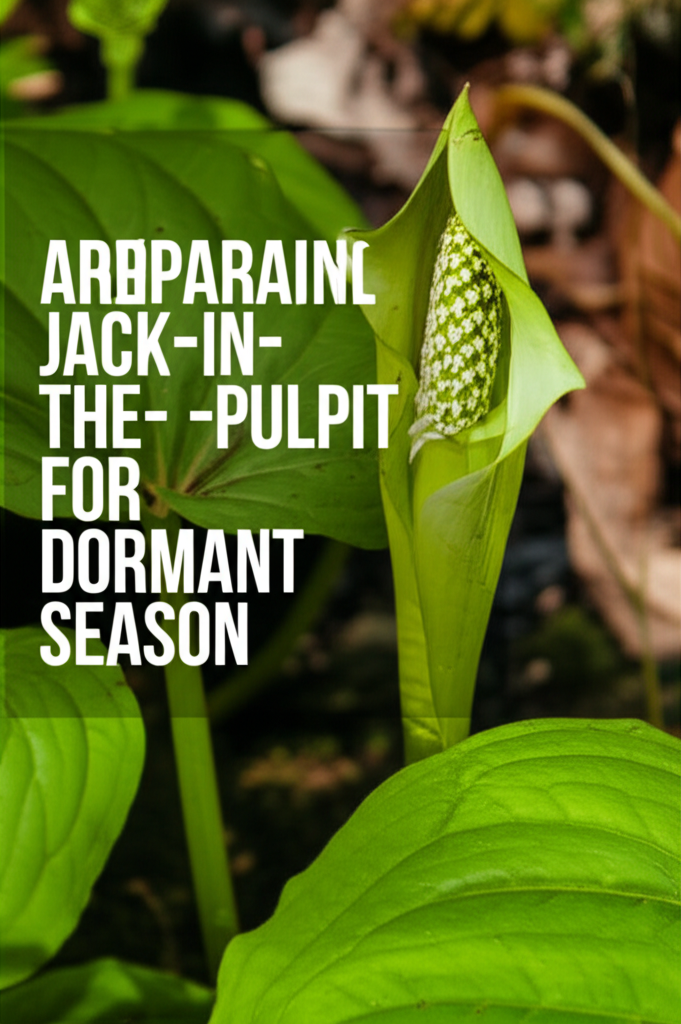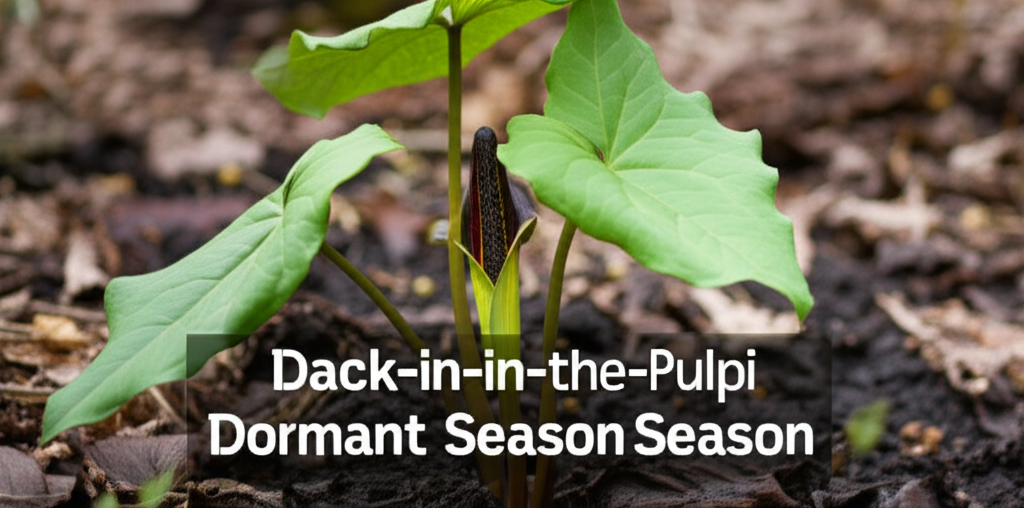Introduction: Welcoming the Dormant Season for Jack-in-the-Pulpit

The Jack-in-the-Pulpit (Arisaema triphyllum) is a captivating native wildflower, renowned for its unique hooded spathe and spadix, resembling a preacher in a pulpit. As the vibrant green foliage begins to fade and the distinctive fruiting spikes emerge in late summer and early autumn, it’s a clear signal that this woodland gem is preparing for its dormant period. Successfully guiding your Jack-in-the-Pulpit through this crucial phase is essential for its survival and robust reemergence the following spring. This comprehensive guide will walk you through the necessary steps to ensure your plants are well-prepared for the cold months ahead, guaranteeing a stunning display season after season.
Understanding the Jack-in-the-Pulpit’s Life Cycle
Before delving into preparation techniques, understanding the plant’s natural life cycle is paramount. Jack-in-the-Pulpit is a perennial herbaceous plant that thrives in moist, shady woodland environments. Its life cycle is characterized by distinct phases:
- Spring Growth: New leaves and the iconic flower emerge from underground corms.
- Summer Development: Foliage matures, and pollination of the flower leads to the development of bright red berries.
- Autumn Transition: Foliage begins to yellow and die back as the plant stores energy in its corm for the upcoming dormancy.
- Winter Dormancy: The above-ground parts die back completely, and the plant rests underground.
- Spring Renewal: The corm breaks dormancy, and the cycle begins anew.
Recognizing the visual cues of the autumn transition is key to knowing when to begin your preparations. The yellowing and browning of leaves, and the appearance of the decorative berry spikes, are your indicators.
Key Preparatory Steps for Dormancy
Preparing Jack-in-the-Pulpit for its dormant season primarily involves ensuring the underground corm is healthy and protected. This involves a few key actions:
1. Allowing Foliage to Die Back Naturally
This is perhaps the most critical step. Resist the urge to cut back the foliage as soon as it starts to yellow. The leaves continue to photosynthesize for a period even as they senesce, providing essential energy reserves for the corm. This stored energy is vital for the plant’s survival through winter and for its vigorous growth in the spring.
- Observe the Signs: Wait until the leaves have completely turned yellow or brown and have started to collapse.
- Avoid Premature Cutting: Cutting green or even partially yellowed foliage deprives the corm of necessary nourishment.
- Natural Decomposition: Once the foliage is significantly withered, you can gently remove it or allow it to decompose in place, acting as a natural mulch.
2. Watering Practices in Autumn
As temperatures cool and rainfall patterns change, your watering needs will shift. While Jack-in-the-Pulpit prefers consistent moisture during its active growing season, the approach to dormancy requires a slight adjustment.
- Reduce Watering: As the plant begins to die back, its water requirements decrease significantly.
- Monitor Soil Moisture: Water only if the soil becomes excessively dry. Avoid waterlogged conditions, which can lead to corm rot.
- Natural Rainfall: In most regions with typical autumn rainfall, additional watering will likely be unnecessary.
3. Mulching for Winter Protection
Mulching is an invaluable practice for protecting the dormant corms from extreme temperature fluctuations and ensuring consistent soil moisture. A good layer of mulch acts as an insulator.
- Timing: Apply mulch once the ground has begun to cool but before the first hard freeze.
- Material Selection: Suitable mulch materials include:
- Shredded leaves (oak leaves are excellent)
- Pine needles
- Composted bark
- Straw (ensure it’s weed-free)
- Depth: Aim for a layer of 2-4 inches of mulch.
- Application: Spread the mulch around the base of the plant, extending out to the drip line, but avoid piling it directly against the stem of the dying foliage.
4. Weed Control
While less critical during dormancy, keeping the area around your Jack-in-the-Pulpit relatively free of perennial weeds can prevent them from competing with your plants next spring.
- Gentle Removal: Carefully remove any persistent weeds before applying mulch.
- Avoid Disturbing the Corm: Be cautious not to damage the underground corm when weeding.
5. Division and Transplanting (If Necessary)
Autumn is an ideal time to divide and transplant Jack-in-the-Pulpit if your plants have become overcrowded or if you wish to relocate them. The plant is actively storing energy, making it resilient to the disturbance.
- Timing: Perform this task after the foliage has died back but before the ground freezes.
- Excavation: Gently excavate the entire clump of corms.
- Division: Separate the corms carefully. You can often see natural divisions.
- Replanting: Replant the corms at the same depth they were previously growing, typically 2-4 inches deep. Ensure they are planted with the pointed side (where new growth emerges) facing upwards.
- Spacing: If replanting multiple corms, space them at least 6-12 inches apart to allow for future growth.
- Watering: Water thoroughly after replanting.
Key Facts and Comparison: Jack-in-the-Pulpit vs. Other Woodland Natives
Understanding how Jack-in-the-Pulpit compares to other common woodland natives can highlight its unique needs and benefits. While many woodland plants share similar preferences for shade and moisture, their dormancy requirements can vary.
| Feature | Jack-in-the-Pulpit (Arisaema triphyllum) | Ferns (e.g., Ostrich Fern) | Trillium (e.g., White Trillium) | Mayapple (Podophyllum peltatum) |
|---|---|---|---|---|
| Dormancy Cue | Foliage dies back completely; berry spikes develop. | Fronds may turn brown and die back or remain semi-evergreen depending on species and climate. | Leaves die back completely after flowering. | Leaves die back completely; seed pods form. |
| Dormancy Protection | Mulching is highly beneficial for corm protection. | Mulching helps retain moisture and protect rhizomes. | Mulching protects rhizomes and conserves moisture. | Mulching protects rhizomes and conserves moisture. |
| Best Time for Division | Autumn (after die-back) or early spring (before new growth). | Spring or autumn. | Autumn (after die-back) or early spring (before new growth). | Early spring or autumn. |
| Light Requirements | Shade to partial shade. | Shade to partial shade. | Shade to partial shade. | Shade to partial shade. |
| Soil Moisture | Consistently moist. | Moist to wet. | Moist. | Moist. |
As evident from the table, the core preparation for Jack-in-the-Pulpit during dormancy—allowing natural die-back and mulching—aligns with many other woodland perennials, emphasizing the importance of respecting the plant’s natural cycle.
Troubleshooting Common Dormancy Issues
While generally hardy, some issues can arise if Jack-in-the-Pulpit is not properly prepared for dormancy.
- Corm Rot: This is the most common problem and is usually caused by overwatering or poor drainage during the autumn and winter months. Ensure the soil is not waterlogged, especially if you are in a region with heavy winter precipitation.
- Winter Kill: In extremely cold climates, an unprotected corm can be susceptible to freezing. Adequate mulching is crucial to prevent this.
- Pests: While less active in dormancy, some pests like slugs and snails can overwinter near the plant. A clean garden bed with minimal leaf litter (where pests can hide) can help.
Post-Dormancy Care: Welcoming Spring
Once winter has passed and the first signs of spring appear, you can begin to anticipate the return of your Jack-in-the-Pulpit.
- Remove Mulch Gradually: As new growth begins to emerge, you can start to gently rake away the mulch. Do this gradually to avoid shocking the emerging shoots.
- Monitor Soil Moisture: As temperatures rise and the plant begins to actively grow, ensure the soil remains consistently moist.
- Avoid Disturbing New Growth: The emerging shoots are delicate. Be mindful of them when gardening.
Pros and Cons of Dormancy Preparation Strategies
Every gardening practice has its advantages and disadvantages. Here’s a look at the pros and cons of the recommended dormancy preparation steps for Jack-in-the-Pulpit.
| Strategy | Pros | Cons |
|---|---|---|
| Allowing Foliage to Die Back Naturally | Provides essential energy reserves for the corm, leading to stronger spring growth. | May appear untidy for a period. Requires patience. |
| Reducing Watering in Autumn | Prevents waterlogged soil and reduces the risk of corm rot. | Requires monitoring to ensure the plant doesn’t dry out excessively in very dry autumns. |
| Mulching for Winter Protection | Insulates the corm from extreme temperatures. Retains soil moisture. Suppresses weeds. | Can harbor slugs and snails if not managed. May delay spring growth slightly if applied too thickly or too early. |
| Division and Transplanting | Allows for propagation of new plants. Improves air circulation in overcrowded clumps. | Can stress the plant if not done carefully. May result in reduced flowering in the immediate following season. |
Environmental Considerations and Native Planting
Preparing Jack-in-the-Pulpit for dormancy isn’t just about plant health; it’s also about ecological stewardship. As a native wildflower, Arisaema triphyllum plays a vital role in its ecosystem.
- Supporting Wildlife: The berry spikes provide a food source for birds and other small animals in the autumn and early winter. Allowing the foliage to decompose naturally also provides habitat for beneficial insects.
- Biodiversity: Planting and properly caring for native species like Jack-in-the-Pulpit contributes to local biodiversity and supports native pollinator populations.
- Sustainable Gardening: By working with the plant’s natural life cycle rather than against it, you embrace a more sustainable and rewarding approach to gardening.
Conclusion: A Rewarding Cycle of Dormancy and Rebirth
The dormant season for Jack-in-the-Pulpit is a period of rest and rejuvenation, crucial for its survival and subsequent splendor. By understanding its life cycle and diligently following the preparatory steps—allowing natural die-back, adjusting watering, and applying protective mulch—you ensure the health and vitality of your plants. This thoughtful approach not only guarantees a magnificent display of these unique wildflowers year after year but also contributes to the well-being of your garden’s ecosystem. Embrace the quiet anticipation of winter, knowing that your efforts will be rewarded with the vibrant return of the Jack-in-the-Pulpit come spring.


